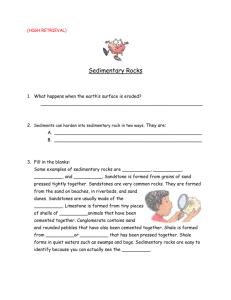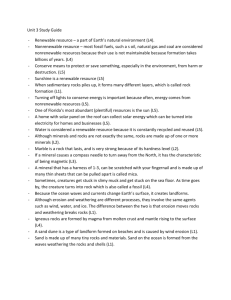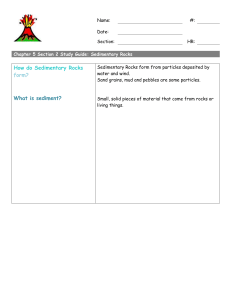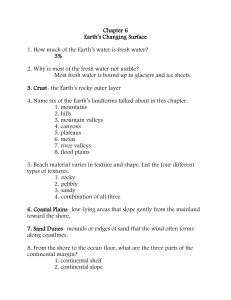ShermanCaitlinExtra3
advertisement
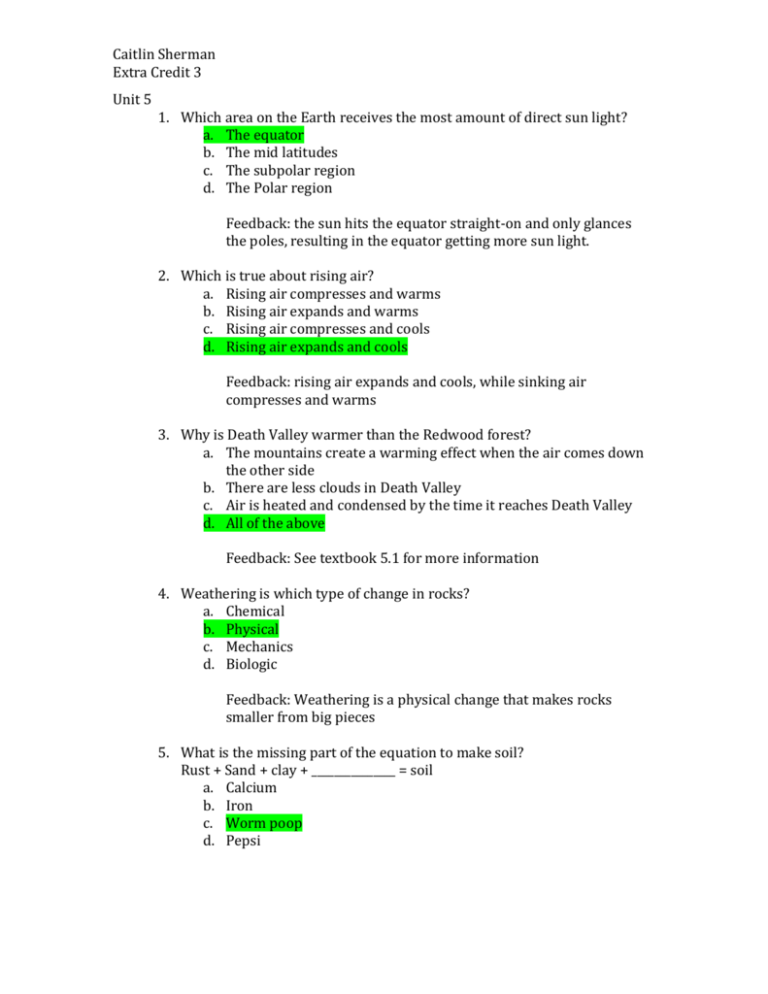
Caitlin Sherman Extra Credit 3 Unit 5 1. Which area on the Earth receives the most amount of direct sun light? a. The equator b. The mid latitudes c. The subpolar region d. The Polar region Feedback: the sun hits the equator straight-on and only glances the poles, resulting in the equator getting more sun light. 2. Which is true about rising air? a. Rising air compresses and warms b. Rising air expands and warms c. Rising air compresses and cools d. Rising air expands and cools Feedback: rising air expands and cools, while sinking air compresses and warms 3. Why is Death Valley warmer than the Redwood forest? a. The mountains create a warming effect when the air comes down the other side b. There are less clouds in Death Valley c. Air is heated and condensed by the time it reaches Death Valley d. All of the above Feedback: See textbook 5.1 for more information 4. Weathering is which type of change in rocks? a. Chemical b. Physical c. Mechanics d. Biologic Feedback: Weathering is a physical change that makes rocks smaller from big pieces 5. What is the missing part of the equation to make soil? Rust + Sand + clay + _______________ = soil a. Calcium b. Iron c. Worm poop d. Pepsi Caitlin Sherman Extra Credit 3 Feedback: the rust, sand, and clay left behind in sediment form, plus a little organic material often including worm poop, becomes layer of soil Unit 6 1. What happens if rocks arrive faster than a river can move them? a. Rocks pile up, creating a lake b. Rocks pile up along the shore making it harder to fish c. Rocks pile up, steepening the stream to move the rocks d. Rocks don’t pile up, the river can always move them Feedback: if more rocks arrive than water can move, rocks pile up, steepening the stream so it can move more rocks 2. A delta builds which way? a. Out but also up b. Out but also down c. In but also out like a fan d. In but also up Feedback: A delta builds out but also up, backing up sediment to bury fields and houses for some distance up stream 3. How thick is the Mississippi delta? a. The Mississippi does not have a delta b. 27 miles c. 17 miles d. 7 miles Feedback: The delta is as much as seen miles thick 4. Why is the location of New Orleans a bad choice? a. It lies in flood plains b. The river isn’t able to build natural levees c. It is sinking d. All of the above Feedback: See textbook 6.2 5. Which rock dissolves very easily? a. Calcium b. Limestone c. Sandstone d. Mudstone Caitlin Sherman Extra Credit 3 Unit 7 Feedback: Limestone dissolves easily creating sinkholes, caves, and springs 1. What types of rocks show a glacier was present? a. Abraded b. Plucked c. Abraded and Plucked d. Neither Feedback: plucked and abraded rocks show clearly that glaciers were present 2. Since water in the ocean is not all the same, one molecule in 500 has an extra what? a. Neutron b. Calcium atoms c. Carbon atoms d. Water in the ocean is all the same Feedback: Water in the oceans is not all the same- roughly one molecule in 500 has an extra neutron or two in one or more of the oxygen or hydrogen atoms. 3. Which hemisphere is the key to controlling ice ages? a. Southern Hemisphere/Summer b. Southern Hemisphere/Winter c. Northern Hemisphere/Summer d. Northern Hemisphere/Winter Feedback: Summer in the northern hemisphere appears to be the key to controlling ice ages. 4. How long ago was the most recent ice age? a. 40,000 years ago b. 30,000 years ago c. 20,000 years ago d. 10,000 years ago Feedback: The most recent ice age was 20,000 years ago, and had a unique glacier tracks across broad areas now far from ice suggests past paths. 5. What percent of land area is covered by ice sheets today a. 40% b. 30% c. 20% Caitlin Sherman Extra Credit 3 d. 10% Unit 8 Feedback: Ice sheets cover about 10% of land area; at the height of the ice age about 30% of modern land was covered. 1. Most transportation on a beach is which of the following a. To and from the beach b. Along the beach c. From the north due to sea breeze d. From the south due to the Gulf Current Feedback: Most transport is to and from the beach, rather than along the beach because most waves turn so that their crests are almost parallel to the beach. 2. In slightly deeper water during a storm the net movement of sand is often: a. A huge amount b. A few big pieces c. A little d. A lot Feedback: there often is a little net movement of sand from the beach into deeper water during storms, which are more common during winter than during summer. 3. Which is the best way to describe long shore drift? a. Water and sand moving away from the beach b. Water and sand moving onto the beach c. Water and sand moving horizontally on the beach d. Water and sand moving along the shore Feedback: long shore drift is water and sand moving along the shore. 4. What made great granite bodes draped in metamorphic sediments? a. The subduction and collision with Europe during the closing of the proto-Atlantic b. The subduction with Europe during the beginning of the protoAtlantic c. The convergence with Europe during the closing of the protoAtlantic d. The convergence with Europe during the beginning of the protoAtlantic Caitlin Sherman Extra Credit 3 Feedback: The subduction and collision with Europe during the closing of the proto-Atlantic made great granite bodies draped in metamorphosed sediment. 5. At what percent was reported on Cape Cod about the U.S. coast eroding? a. 95% b. 80% c. 75% d. 50% Unit 9 Feedback: the Sea Grant Program at the Woods Hole Oceanographic Institution, on Cape Cod, reported that the 75% of the U.S. coastline is eroding, with only 25% stable or advancing. 1. Rocks made entirely of precipitate are called a. Metamorphic rock b. Sedimentary rock c. Basalt d. Organic rock Feedback: look in Textbook 9.2 Bryce Canyon, Sedimentary Rocks section 2. Which rock is not classified as Clastics? a. Shale b. Siltstone c. Geode d. Clay Feedback: Siltstone is slightly coarser pieces of silt. Clay, claystone, and shale are the very smallest clast rocks. The largest clast rocks are cobbles and boulders, or conglomerate. 3. Which is a clue found in sedimentary rocks that tell us how it came to be? a. The clast size or grain size b. The grain shap c. Sorting d. All of the above Feedback: the sized of a clast or grain indicates slow or no currents, the grain shape tells whether it has been transported for in water or wind because transportation knocks off sharp corners making it round, and sorting tells us if wind and water, a landslide, or a glacier moved the piece because each deposit different sized particles 4. How did arch formation start? a. Deposits of sediments including limestone b. Deposits of thick beds of salt Caitlin Sherman Extra Credit 3 c. Deposits from an ancient stream d. Deposits of Pepsi cans from European settlers Feedback: See Textbook 9.2: Arches National Park 5. What is “unconformity”? a. A slab of rock that is not symmetrical b. Outcrop of a mountain side with various erosion patterns c. A time gap in a sedimentary sequence d. Outcrop of a mountain side with various deposit patterns Feedback: the correct answer is a time gap in a sedimentary sequence, which can be caused by actual erosion or lack of deposition




